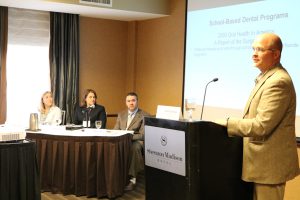At the Annual GrapeVine Conference, we were fortunate to be joined by a number of renowned health experts. Because not everyone is able to attend every breakout session at the conference, we’re taking this opportunity to share some content from an oral health panel. We featured a post on our blog not too long ago from Mary Otto, author of Teeth, which talked about the silent epidemic of inadequate oral health care in the United States. It’s worth revisiting this topic to focus specifically on what is happening in our very own state of Wisconsin.
Our panel at the conference was comprised of some very distinguished oral health professionals – many of whom are known across the state for their work:
 Kelsey Van Handel, RDH, Periodontal Therapist, Meridian Endodontics & Periodontics
Kelsey Van Handel, RDH, Periodontal Therapist, Meridian Endodontics & Periodontics
David Gundersen, DDS, MPH, President, Oral Health Coalition of Dane County
Dixie Schroeder, MBA, Center Research Administrator, Marshfield Clinic
Matt Crespin, MPH, RDH, Associate Director, Children’s Health Alliance of Wisconsin
In their presentations, they took a look at oral health issues and solutions “from the inside-out.” First, looking at the clinical issues related to oral health, then working outwards to explore the systemic innovations, policy challenges, and opportunities for improving access to care for all.
-
Periodontics is dentistry concerned with the structures surrounding and supporting teeth. Periodontal disease starts with an infection of the gums (gingivitis) due to poor hygiene, and if untreated, starts to break down the tissues and bones that support teeth, leading to tooth loss and other problems. There is a strong correlation between periodontal disease and heart disease, diabetes, atherosclerosis, HPV, oral cancer and respiratory problems. Women need to be especially vigilant when it comes to oral care because hormone changes in puberty, menstruation, pregnancy, and menopause/post-menopause can contribute to disease. By bettering overall dental awareness and prevention strategies, one can achieve better well-being.
-
According to the 2000 Oral Health in America Report by the Surgeon General, school-based dental programs increase access to care for students and reduce oral disease and costs. Different types of programs are offered, but may include dental screenings, sealants, other preventive services like cleaning and fluoride, even restorative services like fillings and extractions. Examples of such programs are: Seal-A-Smile, Give Kids a Smile, Celebrate Smiles, Smart Smiles, and Brown County Oral Health Partnership. Many programs will provide services to uninsured children at no charge, and a case manager can help find any needed follow-up care.
-
One major concern to the oral health epidemic is that the mouth is seen as separate from the body. Our dental and medical systems are separate, despite research that clearly states a connection between oral disease and other health diseases. Marshfield Clinic Health System is the only one of its kind in Wisconsin to integrate oral health care with medical care. Their unique medical-dental environment allows comprehensive care for patients, particularly those lacking access and at high risk, to ensure care for the whole body.
-
The Children’s Health Alliance of Wisconsin is “the voice for children’s health.” When it comes to improving oral health access in Wisconsin and beyond, there are 3 buckets to focus on: funding, workforce, and policy. Did you know Wisconsin has THE LOWEST Medicaid fee-for-service reimbursement for dental charges in the country? This provides little incentive for dentists to accept Medicaid patients. Workforce is also an issue as 40% of dentists expect to retire in the next decade, and there will not be enough graduates to replace them. With dental hygienists expected to be in surplus, how can we take advantage of their skills? Policies need to promote better utilization of hygienists and other professionals like dental auxiliaries and dental therapists.